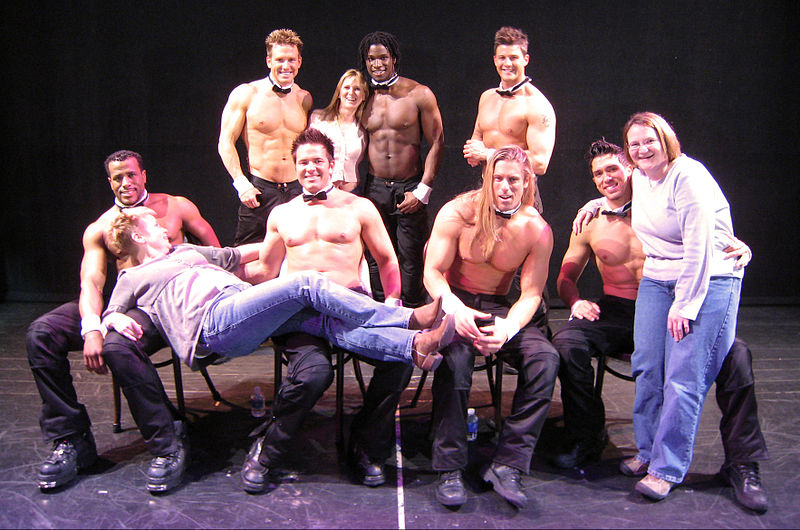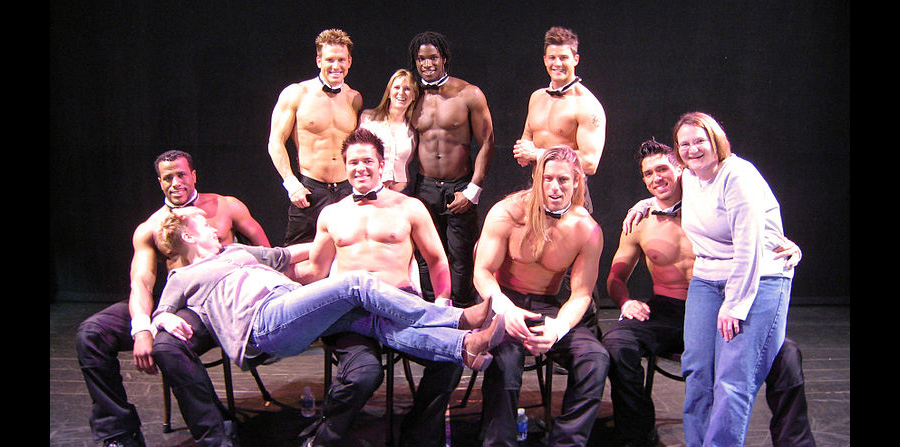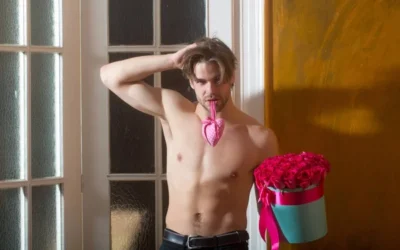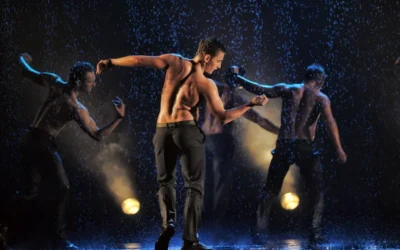
Chippendales Las Vegas
Chippendales is a touring dance troupe best known for its male erotic dancing (striptease) performances and for its dancers’ distinctive upper body costume of a bow tie and shirt cuffs worn on an otherwise bare torso.
Established in the late 1970s, Chippendales was the first all-male stripping troupe to make a business performing for mostly female audiences. Through the quality of its staging and choreography, Chippendales also helped legitimize stripping as a form of popular entertainment.
Today, the company produces Broadway-style shows worldwide and licenses its intellectual property for select consumer products ranging from apparel and accessories to slot machines and video games. The Chippendales perform in a ten-million dollar theater and lounge built specifically for them at the Rio All Suite Hotel and Casino in Las Vegas. Annually, the official men of Chippendales are seen by almost two million people worldwide, performing in more than 25 cities in the U.S., 23 cities in Central and South America, 60 European cities, four Asian countries, and eight South African cities.
Chippendales was founded in 1979 by Somen Banerjee, Paul Snider, and attorney Bruce Nahin. After operating a Mobil gas station and a failed backgammon club, Banerjee bought a failed Los Angeles club named Destiny II and turned it into a nightclub featuring female mud wrestling and a “Female Exotic Dancing Night.” Destiny II was located at 3739 Overland Avenue at McCune Avenue in Palms.
The concept of the male strip show was brought to Nahin and Banerjee by Snider (who subsequently became infamous for killing his estranged wife, Playboy Playmate Dorothy Stratten) and then himself. Broadening the operation, Banerjee soon created Chippendales, which immediately gained a huge female following. Together with Nahin and new partner/choreographer Nicolas De Noia (Snider had died in 1980), Chippendales was expanded to New York’s Club Magique, London, Hamburg, Philadelphia, and Florida. Choreographer de Noia was originally in charge of the stage show, and after awhile he and associate producer Candace Mayeron took the Los Angeles and New York Chippendales on the road and played throughout the East Coast. Authorized shows also toured extensively in the U.S. (by de Noia), Asia, and Europe (through Banerjee).
For Chippendales, the early 1980s were filled with major lawsuits pertaining to personal injury, alleged sexual bias against male guests, and charges of racial discrimination. Eventually, de Noia and Banerjee had a falling-out, and Banerjee brought in choreographer/director Steve Merritt, who, with his partner Mark Donnelly, had stage shows playing in Las Vegas and London. Merritt and Donnelly had the idea of putting the male strippers into a kind of mini-Broadway show, with dancers, music, and themes. To find strippers, they recruited the most attractive men they could find from Venice Beach, Manhattan Beach, and Santa Monica Beach. Merritt taught the men how to perform. He and Donnelly felt that women would respond to male strippers if they were presented in a “safe” (female-only) environment that was about fun and fantasy fulfillment.
Merritt became the choreographer of the Los Angeles show, and ultimately took charge of New York also. This resulted in two separate shows being performed, the de Noia touring version, and the “legitimate” Merritt Version. Once de Noia was killed in 1987, Merritt took control of the touring shows as well.
Chippendales, though still incredibly popular, continued to suffer from legal troubles, conflicts with “copycat” companies, and in 1993, an allegation of murder — that Banerjee had arranged de Noia’s 1987 killing.
Banerjee’s bail was denied, due to testimony that Banerjee had said he intended to pay a private pilot $25,000 to fly him back to India without a passport, and threatened to commit suicide if he was arrested. Soon after, the charges against him were expanded to include the hired hit of de Noia. In the early morning of October 23, 1994, hours away from his sentencing, Banerjee’s body was found hanging in his cell. Because Banerjee wanted to shield his wife from a wrongful death lawsuit and from a $1.75 million fine from the government (Chippendales was worth considerably more than $1.75 million), he killed himself before his trial was technically completed. Banerjee knew that the almost-certain wrongful death suit by Nick de Noia’s relatives would not be able to rely on the higher standard of evidence (“beyond a reasonable doubt” standard, largely recognized to be 95% or more likely to be guilty, required in criminal trials), and the family of de Noia would have to re-prove all of the evidence at any wrongful death trial (a civil standard would apply here, only a mere “preponderance of the evidence” standard, or 51% or more likely to be guilty.)
The entirety of Banerjee’s share in the Chippendales corporation and his estate were passed on, (in the absence of a $1.75 million dollar fine and any successful lawsuit by the de Noia family), to his wife Irene, who thereafter sold the company (without, according to court records, Nahin’s knowledge and without first obtaining Nahin’s permission)to the current owner, Chippendales USA. Nahin remained a shareholder of the company until it was sold following Banerjee’s death. Merritt staged shows at various Chippendales clubs until his death in the 1990s. Irene died of breast cancer in the early 2000s. Mark Donnelly is currently a screenwriter living in Los Angeles.
The company is currently run by Kevin Denberg, whose grandfather ran a Chippendales club in New York City in the 1980s. Kevin Denberg bought Chippendales in 2000 with several other investors, and immediately set about distancing the company from its somewhat risqué past.
Legal affairs
The company continues to battle similar male revues in the courts. Chippendales succesfully registered its “Cuffs and Collar” uniform as a trademark in 2003. However, because this registration was based on “acquired distinctiveness,” Chippendales filed a subsequent application for the same mark in an effort to have the mark recognized as being inherently distinctive. The Trademark Trial and Appeal Board affirmed the decision of the examiner that the mark was not inherently distinctive with one member of the panel dissenting. The Trademark Trial and Appeal Board noted that its decision in no way detracted from the rights flowing from the registration in 2003: “However, the fact that applicant already owns an incontestable registration for the Cuffs & Collar Mark should serve as no small consolation in spite of our decision here.”
On October 1, 2010, the U.S. Court of Appeals for the Federal Circuit affirmed the decision of the Trademark Trial and Appeal Board. Nothing in that decision affected the validity of the 2003 registration. One of the reasons for upholding the decision was the testimony of Chippendales’ own expert, who admitted the male dancers’ outfits were “inspired” by those of the Playboy Bunny, who also feature a bow-tie and shirt cuffs. In April 2011, St. Joseph, Missouri, police shut down a show by a Chippendales impostor group, alleging that it violated Missouri’s adult entertainment laws.
Notable dancers and hosts
Pornographic actor John Stagliano was an original Chippendale dancer, performing with the company for four years into the early 1980s. Similarly, Mark Davis danced with the company for four years in the mid-1980s. Radio host Todd Michaels performed with the company in 1991 and 1995. Twins and Former Australian Rules Footballers Justin Day and Dean Day also made some cameo appearances during 2010 & 2011 but were suspended from future shows due to the explicit nature of their performances.
Recently, former The Bachelor fiancée Vienna Girardi hosted the Chippendales’ “Ultimate Girls Night Out” in November 2010. Karina Smirnoff of Dancing With The Stars hosted the following month.[16] Ronnie Magro of Jersey Shore guest hosted an event in February 2011. Jeff Timmons will be performing with the group through the summer.
In popular culture
Chippendales dancers were the impetus for the plot of the 1997 film The Full Monty. Chippendales was featured in the 2000 film The Chippendales Murder, directed by Eric Bross; and the 2001 film Just Can’t Get Enough. Director Tony Scott is reportedly working on a film about Banerjee and the Chippendales story.
– From Wikipedia, the free encyclopedia






